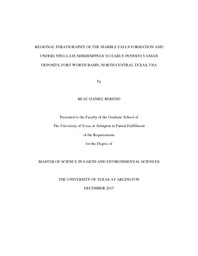| dc.contributor.advisor | Wickham, John | |
| dc.contributor.advisor | Ulysses, Hargrove | |
| dc.creator | Berend, Beau Daniel | |
| dc.date.accessioned | 2016-01-26T22:31:50Z | |
| dc.date.available | 2016-01-26T22:31:50Z | |
| dc.date.created | 2015-12 | |
| dc.date.issued | 2015-12-09 | |
| dc.date.submitted | December 2015 | |
| dc.identifier.uri | http://hdl.handle.net/10106/25427 | |
| dc.description.abstract | The Early Pennsylvanian Marble Falls Formation in the Fort Worth Basin (FWB)
of North-Central Texas was deposited in a broad carbonate ramp system during the initial
stages of Ouachita orogenesis. It extends across an area of more than 15,000 square miles
and comprises an assortment of facies that vary considerably across the region due to
high-frequency sea-level fluctuations. The Marble Falls has been studied extensively in
outcrop around the periphery of the Llano Uplift where it was informally divided into
lower and upper members separated by a regional unconformity representing the
Morrowan-Atokan boundary. A sequence of the Marble Falls Formation was recently
discovered in the northern part of the FWB where it reaches stratigraphic thicknesses of
more than 450 feet and has become a fractured-driven, tight-oil resource play. The
distribution of this unusually thick section was controlled by stratigraphic variations of
several underlying units and extensive well log correlations across the FWB has
presented new evidence that confirms this sequence is part of the lower Morrowan-age
vi
member of the Marble Falls Formation that covers a much larger geographic area than
has been previously estimated. The examination of photomicrographs from whole cores
and side-wall cores have also revealed that the lower Marble Falls is composed almost
entirely of siliceous to partly calcareous sponge spicules similar to that observed in
outcrop and this spiculite facies comprises most of the Marble Falls Formation across the
entire FWB.
This study integrates >20,000 open-hole well logs, micro-resistivity image logs,
petrophysical data, and core data to better understand the regional stratigraphy of the
lower Marble Falls and evaluate its reservoir potential throughout the FWB. It gradually
thickens from its subcrop along the Bend Arch towards the axis of the FWB to the east
and northeast and is characterized by an inner ramp to basin depositional profile. The
influence of foreland basin tectonics and glacio-eustatic sea-level fluctuations are evident
from stratigraphic trends and shallowing-upward parasequences that were identified
within the lower Marble Falls. The complicated lateral variations in these high-frequency
cycles have historically created high-porosity stratigraphic traps along the Bend Arch, but
the present play is concentrated in an area where the lower Marble Falls has little primary
porosity or permeability and the reservoir consists of a network of naturally occurring,
lithology-bound fractures (LBF) that are concentrated in the more siliceous spiculitic
lithofacies. Thorough evaluation of these high-frequency cycles and stratigraphic
variations in the lower Marble Falls is critical in understanding the controls on reservoir
quality and the distribution of reservoir lithofacies. | |
| dc.format.mimetype | application/pdf | |
| dc.language.iso | en_US | |
| dc.subject | Marble Falls | |
| dc.subject | Fort Worth Basin | |
| dc.title | Regional Stratigraphy of the Marble Falls Formation and Underlying Late Mississippian to Early Pennsylvanian Deposits, Fort Worth Basin, North-Central Texas, USA | |
| dc.type | Thesis | |
| dc.date.updated | 2016-01-26T22:31:50Z | |
| thesis.degree.department | Earth and Environmental Sciences | |
| thesis.degree.grantor | The University of Texas at Arlington | |
| thesis.degree.level | Masters | |
| thesis.degree.name | Master of Science in Earth and Environmental Science | |
| dc.type.material | text | |
| dc.creator.orcid | 0000-0003-4292-7288 | |

